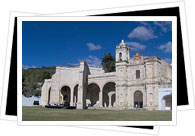|
Spanish Colonial Architecture in Oaxaca, Mexico
The Spanish arrival was particularly prominent in Oaxaca due to the architectural statements they left behind in their organisation of the city. The entire city fits neatly into a typically colonial grid system and the streets were promptly lined with more and more impressive colonial mansions as the Spaniards cashed in on the mining of gold and silver deposits found in the region. The revolution and frequent earthquakes undoubtedly gave many of these buildings a good battering, however, those that have been preserved stand in proud tribute to the Spanish Colonial era. The brightly coloured paintwork of many of the houses adds a quirky touch to Oaxaca's city centre that perfectly complements the city's eclectic culture. Many are used today to house Oaxaca's best museums meaning there is plenty of scope to get inside and have a good snoop around.

You can ogle the Gothic and Renaissance styles that became so prominent during the sixteenth and seventeenth centuries at the Jesuit Templo de la Compañía (Oaxaca Zócalo Tourism). Originally built in 1579, numerous earthquakes kept knocking bits down every time it was rebuilt. Finally it was abandoned for thirty years and sold off privately until it was declared a historic monument in the 1930's and received some much deserved TLC. The temple takes up an entire block and the characteristically gothic facade with detailed carvings and pointed, tierred arches has been delicately restored.
Mexican Baroque began to come in to its own at the start of the seventeenth century and the best examples of this Spanish colonial influenced style can be admired in other religious buildings, primarily Oaxaca's cathedral (Oaxaca Zócalo). This immense construction took over two centuries to complete as those pesky earthquakes kept impeding progress. However, after starting in 1533, Oaxaca Cathedral was finally finished in the eighteenth century with extra thick walls to ensure it remains entirely earthquake proof. The exterior is typical of the Mexican baroque with it's curved arches and statues flanking the entrance. The Basílica de la Soledad (Outside Oaxaca City Centre) is a truly majestic piece of architecture, whose facade is considered one of the most exquisite examples of Mexican baroque in the whole country. Built between 1682 and 1690, the chiaroscuro effects employed in the carvings and tiled frontispiece are particularly dramatic. One of the earliest statements from the Baroque period in Oaxaca is the Iglesia de Santo Domingo (Santo Domingo, Oaxaca) and the ex-convent building which backs on to it which were built between 1570 and 1608..
The eighteenth century Templo de San Felipe Neri (Outside Oaxaca City Centre ) is a particularly interesting piece of Oaxaca architecture as it fuses together multiple aspects of Spanish colonial architecture. Built between 1733 and 1770 the carving on the outside closely mixes baroque style with the typically renaissance exuberance of the plateresque. However, the interior, in particular the multiple altar pieces, reflect the flamboyant ornamentation of the later baroque stages - the Churrigueresque.
Finally. one of the last styles to develop during the Spanish Colonial era was the Neoclassical. Oaxaca's best example can be found in the Zócalo at the Palacio de Gobierno. However, this is not an entirely original model as earthquake damage meant it underwent severe restoration in the 1930's.
|